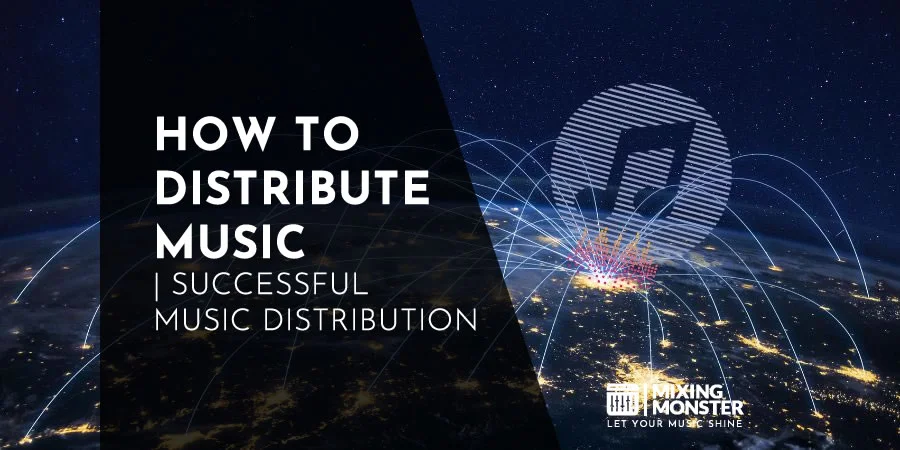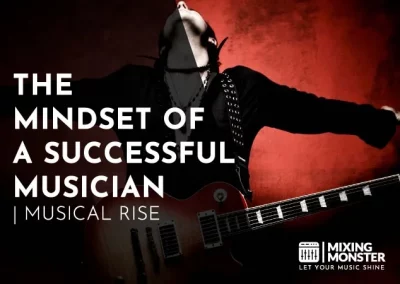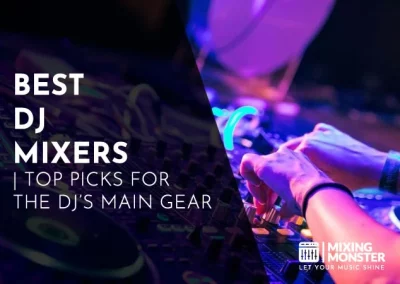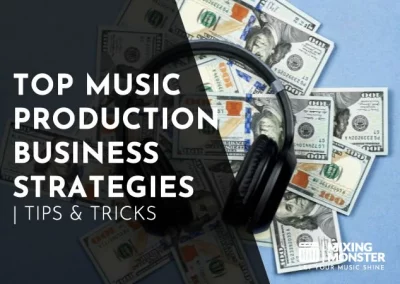Home > Blog > Music > Music Industry
Disclosure: Some of the links below are affiliate links, meaning that at no additional cost to you, we will receive a commission if you click through and make a purchase. Read our full affiliate disclosure here.
Distributing music in today’s digital landscape is critical for artists looking to reach a wider audience and establish a foothold in the music industry. Understanding how to distribute music is essential for getting your songs heard by listeners across the globe on various streaming platforms and digital music stores.
The music distribution process involves getting your music out of the studio and into the public’s ears. This encompasses everything from selecting the right distribution service to understanding the financial aspects of streaming royalties. Your music must be formatted appropriately, metadata included, and rights secured—these are integral steps in preparing your music for release.
Music distribution bridges your creative output and potential fans, ensuring your tracks are available wherever they consume music. It is about shaping your musical brand, creating an online presence, and connecting with your audience. As you delve into the ins and outs of distributing music, you’ll uncover ways to monetize your music, tailor your marketing and promotion strategies, and tap into resources that can help amplify your music’s reach.
KEY TAKEAWAYS:
- Understanding music distribution is essential for artists to reach listeners worldwide.
- Correct formatting and securing music rights are crucial before distribution.
- A strong online presence and marketing complement effective distribution.
Table Of Contents
1. Basics Of How To Distribute Music
2. Preparing Your Music For Release
3. Choosing A Music Distribution Service
4. Maximizing Online Presence
5. Monetizing Your Music
6. Music Marketing And Music Promotion Strategies
7. Wrapping Up How To Distribute Music
8. FAQ

1. Basics Of How To Distribute Music
Understanding the essentials of music distribution is crucial in your journey as an artist. Music distribution is the bridge between your finished record and your future fans. It encompasses two main types: digital music distribution and physical distribution.
For digital distribution, you typically use music distribution services to get your music on platforms such as Spotify, Apple Music, and Amazon Music. A digital music distribution service will handle the digital delivery of your music to these various streaming sites and online stores. They ensure your tracks are formatted appropriately, metadata is correct, and royalties are collected.
Physical distribution involves producing and supplying tangible music formats like CDs or vinyl. This form is more challenging for independent artists due to cost and inventory management. Still, it can be a valuable part of your strategy, especially for releases or merchandise tables at shows.
In choosing a music distribution service, consider these factors:
- Reach:
Does it distribute to all the platforms your audience uses? - Fees:
Is it a one-time fee, annual charge, or commission-based? - Features:
Does it offer pre-saves, promotional support, or analytics? - Ease Of Use:
Is the platform easy to navigate and manage?
Some popular music distributors for digital distribution include DistroKid, TuneCore, and CD Baby. For free services, options like Amuse or SoundCloud can be starting points. Remember, these companies mediate between you and streaming services or stores; they don’t typically promote your music. Promotion is usually your responsibility, so plan accordingly.
2. Preparing Your Music For Release
Before you release your music, ensure every detail, from audio quality to album artwork, meets industry standards. Your songs’ presentation can significantly impact their market reception.
Finalizing Your Tracks For Release
To finalize your tracks for release:
- Start with a critical listening session.
- Check your mixes for balance and clarity, comparing them against commercial releases in similar genres.
- Confirm that your mastering is done professionally to ensure your songs compete well on streaming platforms. It’s
Setting a release date that allows ample time for distribution setup and promotional activities is crucial.
- Checklist For Finalizing Tracks:
- Ensure mixes are balanced.
- Professional mastering is complete.
- Select an appropriate release date.
Creating Artwork And Metadata
Your single or album requires compelling artwork that captures the essence of your music. Artwork must adhere to distributor specifications and resonate with your target audience.
Similarly, accurate metadata is essential, including track titles, artist names, and other relevant information that aids in cataloging and discovering your music. This metadata should be double-checked for accuracy to avoid any release-day issues.
- Metadata Must-Haves:
- Artist name
- Track titles
- Release date
- Genre
- Composer and songwriter credits
Remember, your artwork and metadata are as vital as the music; they are crucial to your songs’ first impression and discoverability.
3. Choosing A Music Distribution Service
When selecting a music distribution service, it is essential to assess the available platforms, understand their costs and plans, and follow a systematic approach to distributing your music.
Evaluating Music Distribution Platforms
To start, you must evaluate which distribution platform best suits your needs. Consider factors like their distribution reach, whether they grant you rights to keep 100% of your royalties, and if they offer promotional tools or analytics. Choose among leading distributors like DistroKid, TuneCore, CD Baby, or Amuse based on which align with your career trajectory and distribution goals.
Comparing Music Distribution Costs And Plans
It’s crucial to compare the costs and plans of various distribution services. These companies often have different pricing models – from annual fees to taking a percentage of your royalties.
For example, services like DistroKid offer a flat yearly fee, allowing unlimited uploads, while TuneCore charges per release. Boldly weigh each distributor’s offerings against their price to find your best-fit service.
How To Distribute Music Step-By-Step
Follow these steps to distribute your music effectively:
- Research and select a distributor that matches your needs.
- Prepare high-quality audio files and artwork conforming to platform specifications.
- Create accounts or profiles on desired streaming services.
- Upload your music through the distributor, adding metadata such as song titles, artist names, and genres.
- Set a release date, giving enough lead time for promotional activities.
- Review all details before finalizing the submission.
- Use the tools provided by your distributor for marketing and tracking your release.
Here is a table comparing various music distribution platforms to help you choose:
| Distributor | Costs | Format | Royalties | Features | |
|---|---|---|---|---|---|
| DistroKid | Annual fee for unlimited uploads | Singles, EPs, Albums | 100% | HyperFollow, Splits | |
| CD Baby | Per-release fee; standard: $9.95 single, $29 album | Singles, Albums | 91% | Sync Licensing, CD/DVD Distribution | |
| TuneCore | Per-release; $9.99 for single, $29.99 for album | Singles, Albums | 100% | Publishing Administration, Store Automator | |
| Amuse | Free tier or Pro tier with an annual fee | Singles, EPs, Albums | 100% (Pro) | Music Intelligence, Fast Forward | |
| UnitedMasters | Free with 10% commission; $5/m subscription | Singles, EPs, Albums | 90% (Free), 100% (Subscription) | Brand opportunities, Store Automator |
Using this information, reflect on your career needs and distribution aspirations before choosing a distributor—select one adept at meeting your requirements to help propel your music career forward.
4. Maximizing Online Presence
Creating a robust online presence is vital for music distribution. Your aim should be to capture attention on platforms where potential fans spend their time, from streaming services to social media.
Utilizing Social Media And Streaming Platforms
Create and maintain active profiles across major streaming platforms like Spotify, Apple Music, Amazon Music, Pandora, Deezer, and iTunes to heighten your visibility. Ensure your profiles reflect your brand and are current with your latest releases.
Next, focus on social media platforms. Sites like Facebook, Instagram, and TikTok are excellent for sharing behind-the-scenes content announcements and engaging directly with your fans. Consistent activity will strengthen your connection with your audience:
- Instagram & Facebook:
Post teaser stories and go live to engage with fans. - TikTok:
Create challenge campaigns or use trending sounds to get discovered. - Twitter:
Share updates and connect with the music community and influencers.
Engaging With Video Platforms And Playlists
Video platforms like YouTube play a crucial role in music discovery and fan engagement. Create a YouTube channel to share music videos, live performances, and personal vlogs:
- Official Videos:
Boost visibility with well-produced music videos. - Playlists:
Get featured on user-generated or curated playlists to reach new listeners.
For playlists, also make your tracks accessible on streaming services’ playlists. Submit your music through the streaming services’ artist platforms, such as Spotify for Artists, often by uploading music with enough lead time before the release date.
Explore collaboration with music blogs and other online curators to feature your music. This can lead to inclusion on influential playlists, streaming services, and social media platforms.
Remember to monitor which platforms and strategies gain the most traction and use those insights for future releases.

5. Monetizing Your Music
Monetizing your music involves understanding the nuances of royalties and rights. It would help if you also tapped into various revenue streams to ensure you maximize the financial potential of your work.
Understanding Music Royalties And Rights
Royalties are the financial payments you receive when your music is used or sold. Meanwhile, music publishing involves the copyrights of your compositions, which entitle you to publishing royalties.
When your music is streamed on major platforms like Spotify or Apple Music, you earn less from streaming royalties per play than downloads. Downloads generally give you a higher revenue per purchase.
- Performance Royalties:
When your music is played publically, through radio, in venues, or online streams. - Mechanical Royalties:
From the reproduction of your recorded music. - Synchronization (Sync) Royalties:
Generated when your music is paired with visual media.
With copyrights, you protect your intellectual property. This ensures you’re the one benefiting from these royalties.
Meanwhile, music promotion and PR efforts can amplify your visibility, leading to more plays and royalties.
Exploring Additional Revenue Streams
Your income isn’t limited to royalties; there are several other avenues to explore:
- Sync Licensing:
License your music for TV, films, and advertisements. - Merchandising:
Sell branded goods to your fans. - Live Performances:
Ticket sales and live performance fees can be significant. - Teaching:
Offer lessons or workshops sharing your expertise.
Be proactive in music promotion to drive attention to your music. Getting on playlists and leveraging the algorithms of significant streaming platforms can result in more streams and royalties. Please pay attention to the power of intellectual property; it’s the core of your monetization strategy.
6. Music Marketing And Music Promotion Strategies
A well-crafted marketing plan and leveraging customer service and analytics for growth are essential to boosting your music career.
Building A Music Marketing Plan
Your music marketing plan is a roadmap that guides you from where you are now in your music career to where you want to be.
Start by defining your goals: do you want to increase your fan base, or are you aiming to get your music on a major Spotify playlist? Understanding your end goal will shape your strategy.
Next, identify your target audience. Who are they, what do they like, and where do they typically consume music? Your plan should detail specific marketing tactics tailored to your audience, such as engaging music videos or behind-the-scenes content.
Be realistic about your budget and resources. You must allocate funds for promotions, advertisements, and, potentially, collaborations with influencers or other artists.
Remember to schedule your releases to maximize exposure. A staggered release of singles leading up to an album can keep your audience engaged and anticipate your next move.
Leveraging Customer Service And Analytics for Growth
In the music industry, your fans are your customers, and excellent customer service is mandatory. Engage with your fans on social media, email newsletters, and live events. This makes them feel valued and part of your journey.
Use social media analytics to understand the content they engage with the most and tailor your future posts accordingly. Analytics plays a significant role in informing your decisions.
Platforms such as Spotify and YouTube provide detailed insights to help you understand your listeners’ behavior.Use this data to refine your music promotion strategies, including geo-targeted advertising, music tours, or localized marketing campaigns.
Your ability to analyze data and provide exceptional customer service can drastically improve your fan base and elevate your standing in the competitive music market.
7. Wrapping Up How To Distribute Music
This final section will focus on cementing the essential steps you’ve learned about music distribution.
Key Takeaways For Music Distribution
- Choose A Music Distributor:
Selecting the right music distributor is crucial as they will get your music onto platforms like Spotify and Apple Music. - Understand The Process:
Before distribution, familiarize yourself with the music production process, which includes writing, recording, mixing, and mastering. This ensures that your music is of the best quality when it reaches your audience. - Comprehensive guides can break this down further to ensure you get all the vital steps.
- Self-Release Options:
Know how to distribute music independently, including direct sales through your website or online stores. Self-releasing can give you more control and might be suitable if you prefer the DIY route. - Artist Profiles & Verification:
Ensure you have claimed and verified your artist profiles on streaming services. Verification provides credibility and can be necessary for accessing artist analytics and customizing your profile. - Availability Across Platforms:
To maximize reach and exposure, your music should be widely available, not just on music stores and streaming platforms but also on social media platforms. - Marketing & Promotion: In addition to distribution, actively market and promote your music to increase its visibility. This can involve social media marketing, playlist pitching, and more.
- Monitor Your Music’s Performance:
Regularly review analytics from your distributor and streaming platforms to understand your audience and strategize future releases.
Happy music distribution!
Mixing
Service
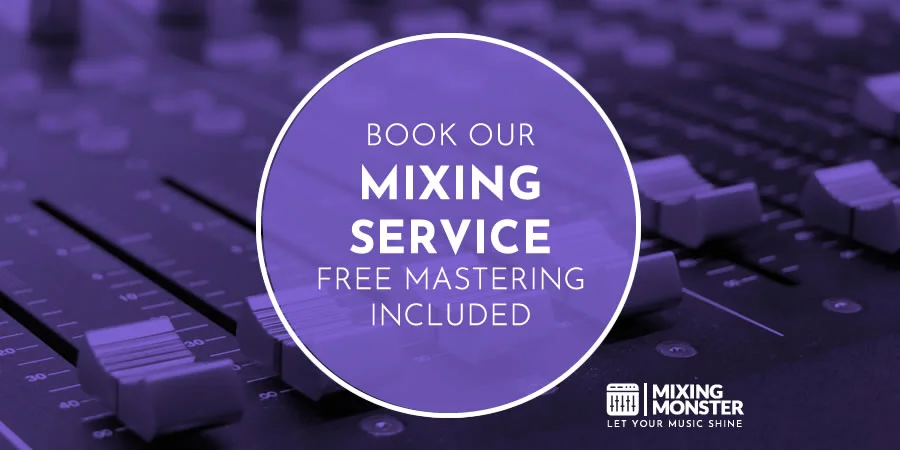
Mastering
Service

8. FAQ
1) What are the steps to self-distribute my music?
To self-distribute your music, you must finalize your tracks with professional mastering. Then, select a distribution service that aligns with your needs, such as Distrokid, for digital distribution. You can set up your artist profile, upload your music, metadata, and artwork, and set a release date.
2) What are the costs associated with distributing my music?
Costs can vary depending on the distribution platform; some services may charge an upfront fee, while others take a percentage of royalties. For instance, platforms like DistroKid offer a yearly subscription fee, allowing unlimited uploads.
3) How can I distribute my music on Spotify specifically?
To distribute music on Spotify, you’ll need to work with a digital music distribution service. These services usually require you to create an account, upload your music and artwork, and submit your tracks for distribution to Spotify and other platforms.
4) Which platforms are most effective for independent artists' music distribution?
Platforms like Spotify, Apple Music, Bandcamp, and SoundCloud are effective for digital distribution. Each has its unique audience and benefits for independent artists.
5) Can you distribute music for free, and if so, how?
Yes, you can distribute music for free using platforms such as SoundCloud or by offering your music directly to fans via your website. Some distributors may offer free plans, generally taking a higher royalty percentage in return.
6) What advantages do music distribution labels offer over self-distribution?
Distribution labels can offer broader reach, marketing support, and industry contacts. These can be challenging to secure when distributing independently. They often have established relationships with major streaming platforms and retailers, making your music more accessible to a wider audience.

